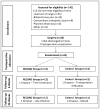Effects of Weight-Bearing Biofeedback Training on Functional Movement Patterns Following Total Knee Arthroplasty: A Randomized Controlled Trial
- PMID: 26207975
- PMCID: PMC4558346
- DOI: 10.2519/jospt.2015.5593
Effects of Weight-Bearing Biofeedback Training on Functional Movement Patterns Following Total Knee Arthroplasty: A Randomized Controlled Trial
Abstract
Study design: Randomized controlled trial.
Objectives: To examine the effects of weight-bearing biofeedback training on weight-bearing symmetry and functional joint moments following unilateral total knee arthroplasty.
Background: Individuals after unilateral total knee arthroplasty place more weight on the nonsurgical limb compared to the surgical limb during function. It is unknown whether targeted intervention can improve function in the surgical limb and resolve altered movement patterns.
Methods: Twenty-six patients were randomly assigned to 2 groups (reload or control). The reload group had a standard-of-care rehabilitation augmented with weight-bearing biofeedback training, and the control group had a dose-matched standard-of-care rehabilitation. Lower-limb weight-bearing ratios were measured preoperatively and 6 and 26 weeks after total knee arthroplasty during a 5-time sit-to-stand test (FTSST) and walking. Secondary outcomes were FTSST time, walking speed, and lower-limb joint moments during the FTSST and walking.
Results: No between-group differences were found in weight-bearing ratios. Five-time sit-to-stand test time improved in the reload group compared to the control group at 6 (P = .021) and 26 weeks (P = .021). There were no between-group differences in knee extension moment during the FTSST. Surgical-limb knee extension moments during walking increased from baseline to 26 weeks in the reload group and decreased in the control group (P = .008).
Conclusion: Weight-bearing biofeedback training had no effect on functional weight-bearing symmetry or knee extension moments during the FTSST. However, the biofeedback training resulted in increases of knee extension moments during gait and improved FTSST times. Trial registered at ClinicalTrials.gov (NCT01333189). Level of Evidence Therapy, level 2b.
Keywords: TKA; gait; joint moments; movement asymmetry; sit-to-stand.
Conflict of interest statement
The authors certify that they have no affiliations with or financial involvement in any organization or entity with a direct financial interest in the subject matter or materials discussed in the article.
Figures



References
-
- Barthuly AM, Bohannon RW, Gorack W. Gait speed is a responsive measure of physical performance for patients undergoing short-term rehabilitation. Gait Posture. 2012;36:61–64. - PubMed
-
- Bohannon RW, Glenney SS. Minimal clinically important difference for change in comfortable gait speed of adults with pathology: a systematic review. Journal of evaluation in clinical practice. 2014;20:295–300. - PubMed
-
- Boonstra MC, De Waal Malefijt MC, Verdonschot N. How to quantify knee function after total knee arthroplasty? Knee. 2008;15:390–395. - PubMed
-
- Boonstra MC, Schwering PJ, De Waal Malefijt MC, Verdonschot N. Sit-to-stand movement as a performance-based measure for patients with total knee arthroplasty. Phys Ther. 2010;90:149–156. - PubMed
-
- Chehab EF, Favre J, Erhart-Hledik JC, Andriacchi TP. Baseline knee adduction and flexion moments during walking are both associated with 5 year cartilage changes in patients with medial knee osteoarthritis. Osteoarthritis and cartilage / OARS, Osteoarthritis Research Society. 2014;22:1833–1839. - PMC - PubMed
Publication types
MeSH terms
Associated data
Grants and funding
LinkOut - more resources
Full Text Sources
Other Literature Sources
Medical

